Testability Protocol and Service Primitives
AUTOSAR TC Release 1.1.0
Document Title
Document Owner
Document Responsibility
Document Identification No
Document Classification
Document Status
Part of AUTOSAR Product
Part of Product Release
Testability Protocol and
Service Primitives
AUTOSAR
AUTOSAR
778
Auxiliary
Final
Acceptance Tests for Classic Platform
1.1.0
Document Change History
Release Changed by
Change Description
1.1.0 AUTOSAR
Initial release
Release
Management
1 of 29
Document ID 778: AUTOSAR_PRS_TestabilityProtocolAndServicePrimitives
- AUTOSAR Confidential -
�
Testability Protocol and Service Primitives
AUTOSAR TC Release 1.1.0
Disclaimer
This specification and the material contained in it, as released by AUTOSAR, is for
the purpose of information only. AUTOSAR and the companies that have contributed
to it shall not be liable for any use of the specification.
The material contained in this specification is protected by copyright and other types
of Intellectual Property Rights. The commercial exploitation of the material contained
in this specification requires a license to such Intellectual Property Rights.
This specification may be utilized or reproduced without any modification, in any form
or by any means, for informational purposes only. For any other purpose, no part of
the specification may be utilized or reproduced, in any form or by any means, without
permission in writing from the publisher.
The AUTOSAR specifications have been developed for automotive applications only.
They have neither been developed, nor tested for non-automotive applications.
The word AUTOSAR and the AUTOSAR logo are registered trademarks.
Advice for users
AUTOSAR specifications may contain exemplary items (exemplary reference
models, "use cases", and/or references to exemplary technical solutions, devices,
processes or software).
Any such exemplary items are contained in the specifications for illustration purposes
only, and they themselves are not part of the AUTOSAR Standard. Neither their
presence in such specifications, nor any later documentation of AUTOSAR
conformance of products actually implementing such exemplary items, imply that
intellectual property rights covering such exemplary items are licensed under the
same rules as applicable to the AUTOSAR Standard.
2 of 29
Document ID 778: AUTOSAR_PRS_TestabilityProtocolAndServicePrimitives
- AUTOSAR Confidential -
�
Testability Protocol and Service Primitives
AUTOSAR TC Release 1.1.0
Table of Contents
1
Introduction and Functional Overview ................................................................. 5
2 Acronyms and Abbreviations ............................................................................... 6
3 Related Documentation ....................................................................................... 7
3.1
Input documents ........................................................................................... 7
3.2 Related Standards and Norms ..................................................................... 7
3.3 Related specification .................................................................................... 7
4 Constraints and Assumptions .............................................................................. 8
4.1
4.2
Limitations .................................................................................................... 8
Applicability to car domains .......................................................................... 8
5
Intended context and applicability of protocol ...................................................... 9
5.1 Dependencies to other protocol layers ......................................................... 9
5.2 Dependencies to other standards and norms ............................................... 9
6 Protocol Specification ........................................................................................ 10
6.7.1
6.7.2
6.7.3
6.7.4
6.7.5
6.1 Message Format and Protocol Fields ......................................................... 10
6.2 Message Exchange .................................................................................... 11
6.3
States of Service Primitives ........................................................................ 12
6.4 Default Behavior ......................................................................................... 12
6.5 Constraints ................................................................................................. 12
6.6
Extensibility ................................................................................................ 12
6.7 Data Types and Format .............................................................................. 13
Boolean ............................................................................................... 13
Unsigned ............................................................................................. 13
Signed ................................................................................................. 13
Floating Point ...................................................................................... 13
Variable Length ................................................................................... 14
6.8 Result IDs ................................................................................................... 15
Standard Results ................................................................................. 15
Testability Specific .............................................................................. 15
Service Primitive Specific .................................................................... 15
Service Groups........................................................................................... 16
6.9.1 General Group .................................................................................... 16
UDP Group.......................................................................................... 17
6.9.2
6.9.3
TCP Group .......................................................................................... 17
6.10 Service Primitives ....................................................................................... 18
6.10.1 Get Version ......................................................................................... 18
6.10.2 Start Test............................................................................................. 19
6.10.3 End Test .............................................................................................. 19
6.10.4 Close Socket ....................................................................................... 20
6.8.1
6.8.2
6.8.3
6.9
3 of 29
Document ID 778: AUTOSAR_PRS_TestabilityProtocolAndServicePrimitives
- AUTOSAR Confidential -
�
Testability Protocol and Service Primitives
AUTOSAR TC Release 1.1.0
6.10.5 Create and Bind .................................................................................. 20
6.10.6 Send Data ........................................................................................... 21
6.10.7 Receive and Forward .......................................................................... 22
6.10.8 Listen and Accept ................................................................................ 23
6.10.9 Connect ............................................................................................... 23
6.10.10 Configure Socket ............................................................................. 24
6.11 Standard Extensions .................................................................................. 25
6.11.1 Shutdown ............................................................................................ 25
6.12 Use Cases .................................................................................................. 26
6.12.1 UDP Transmit ...................................................................................... 26
6.12.2 UDP Receive and Count ..................................................................... 27
6.12.3 TCP Server Transmit .......................................................................... 27
6.12.4 TCP Client Receive and Forward ........................................................ 28
7 Changes to Previous Versions .......................................................................... 29
4 of 29
Document ID 778: AUTOSAR_PRS_TestabilityProtocolAndServicePrimitives
- AUTOSAR Confidential -
�
Testability Protocol and Service Primitives
AUTOSAR TC Release 1.1.0
1
Introduction and Functional Overview
This document details the specification of a communication control protocol with the
objective of triggering service primitives (Service Primitives) that imply actions or
observations on an implantation under test (IUT). To trigger the actions and
observations a testability module/upper tester (UT) that implements the service
primitives is located inside the device under test (DUT). The control communication
using this protocol takes place on the control channel (CC) between Test System and
UT. The actions and observations are exercised through the upper interface that the
IUT exposes to its upper layers, the upper test channel (UC). The actions are
intended to cause the IUT to communicate with the lower tester (LT) on the lower test
channel (LC), wherein the test system verifies the IUT behavior. The test system can
also stimulate the IUT to negative scenarios in order to validate the robustness of the
IUT. There are several ways to setup the test environment.
t
s
e
T
r
e
d
n
U
e
c
v
e
D
i
Upper Tester
(UT)
CC
Test
System
UC
Implementation
Under Test
(IUT)
LC
Lower Tester
(LT)
t
s
e
T
r
e
d
n
U
e
c
v
e
D
i
Upper Tester
(UT)
UC
CC
Implementation
Under Test
(IUT)
LC
CC
Lower Tester
e.g. Ethernet
(LT)
Test
System
Logic setup of the test
environment
Scheme of the test environment using the
control channel though the IUT itself
5 of 29
Document ID 778: AUTOSAR_PRS_TestabilityProtocolAndServicePrimitives
- AUTOSAR Confidential -
�
Testability Protocol and Service Primitives
AUTOSAR TC Release 1.1.0
2 Acronyms and Abbreviations
Acronyms and abbreviations which have a local scope and therefore are not
contained in the AUTOSAR glossary.
Abbreviation /
Acronym:
Description:
IUT
SP
UT
TSB
TM
LT
UC
LC
CC
TS
EVB
GID
PID
TID
RID
DUT
Implementation Under Test
Service Primitive (for triggering actions or observations on the IUT)
Upper Tester (Part of TS that contains the SPs located within the
DUT on top of the IUT)
Test Stub (same as UT)
Testability Module (same a UT)
Lower Tester (Part of TS located outside the DUT on bottom of the
IUT)
Upper Test Channel (channel between UT and IUT within the DUT)
Lower Test Channel (channel between LT and IUT that can be
accessed from outside the DUT)
Control Channel (The channel between TS and UP used to call
SPs that can be accessed from outside the DUT)
Test System (The system that contains the test cases and control
for UT and LT)
Event Bit (Protocol field that is set in case of an event)
Group Identifier (Protocol field: determines a group of services)
Service Primitive Identifier (Protocol field: determines a service)
Type Identifier (Protocol field: to determine the message type)
Result Identifier (Protocol field: similar to a Return Error Code)
Device Under Test (contains the UT and IUT that is tested)
6 of 29
Document ID 778: AUTOSAR_PRS_TestabilityProtocolAndServicePrimitives
- AUTOSAR Confidential -
�
Testability Protocol and Service Primitives
AUTOSAR TC Release 1.1.0
3 Related Documentation
In this chapter lists all related documentation.
3.1 Input documents
[1] AUTOSAR SOME/IP Protocol Specification
AUTOSAR_PRS_SomeIPProtocol.pdf
[2] AUTOSAR Standard Datatypes
AUTOSAR_SWS_StandardTypes.pdf
3.2 Related Standards and Norms
No related standards
3.3 Related specification
Thus, the specification AUTOSAR SOME/IP Protocol Specification [1] shall be
considered as additional and required specification for the testability protocol
7 of 29
Document ID 778: AUTOSAR_PRS_TestabilityProtocolAndServicePrimitives
- AUTOSAR Confidential -
�
Testability Protocol and Service Primitives
AUTOSAR TC Release 1.1.0
4 Constraints and Assumptions
4.1 Limitations
Although the testability protocol format is compatible to the SOME/IP protocol the
message exchange behavior is different. “Request/response” communication is
supported but extended by optional notification events. There is no “fire and forget” or
“publish/subscribe” communication.
A secure mechanism to prevent unauthenticated access to service primitives is not
part of this document but should be realized.
4.2 Applicability to car domains
There are no known dependencies to certain car domains.
8 of 29
Document ID 778: AUTOSAR_PRS_TestabilityProtocolAndServicePrimitives
- AUTOSAR Confidential -
�

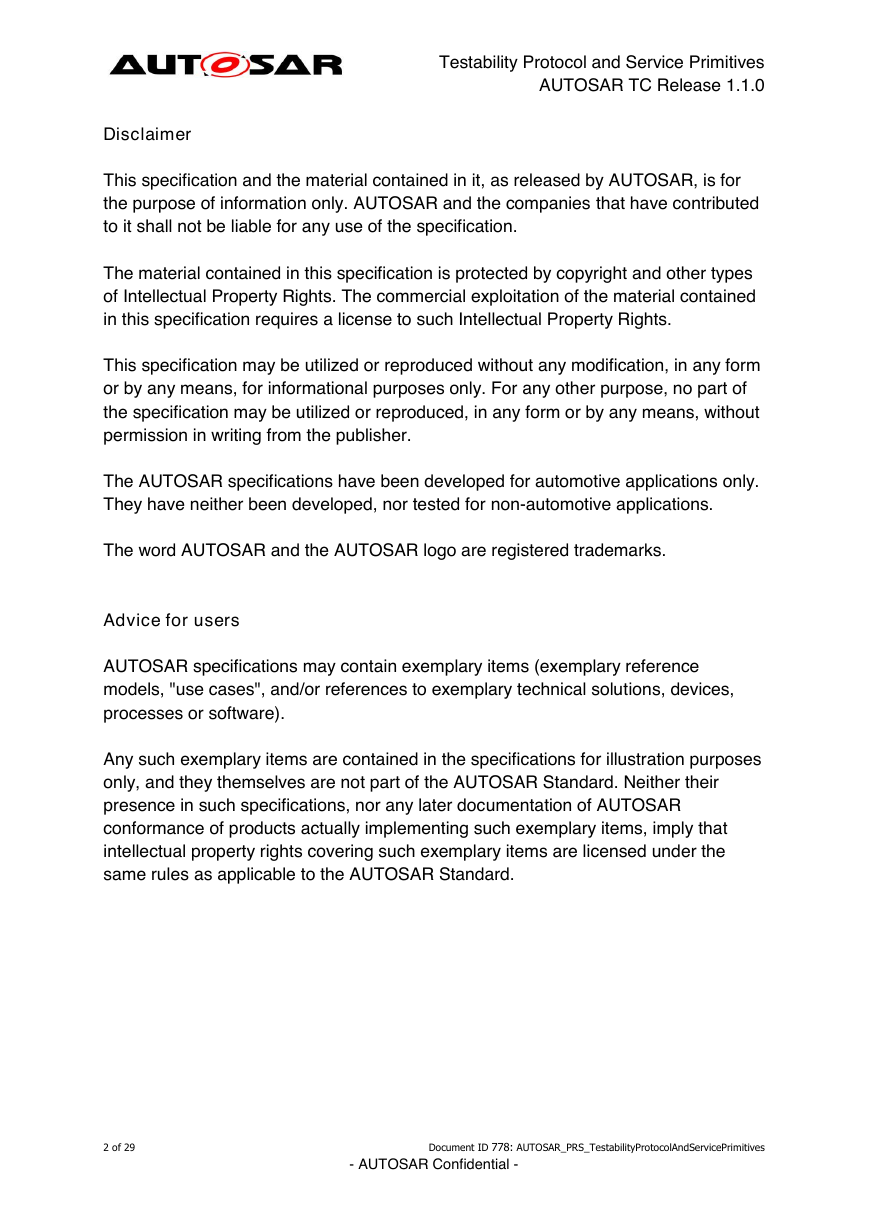
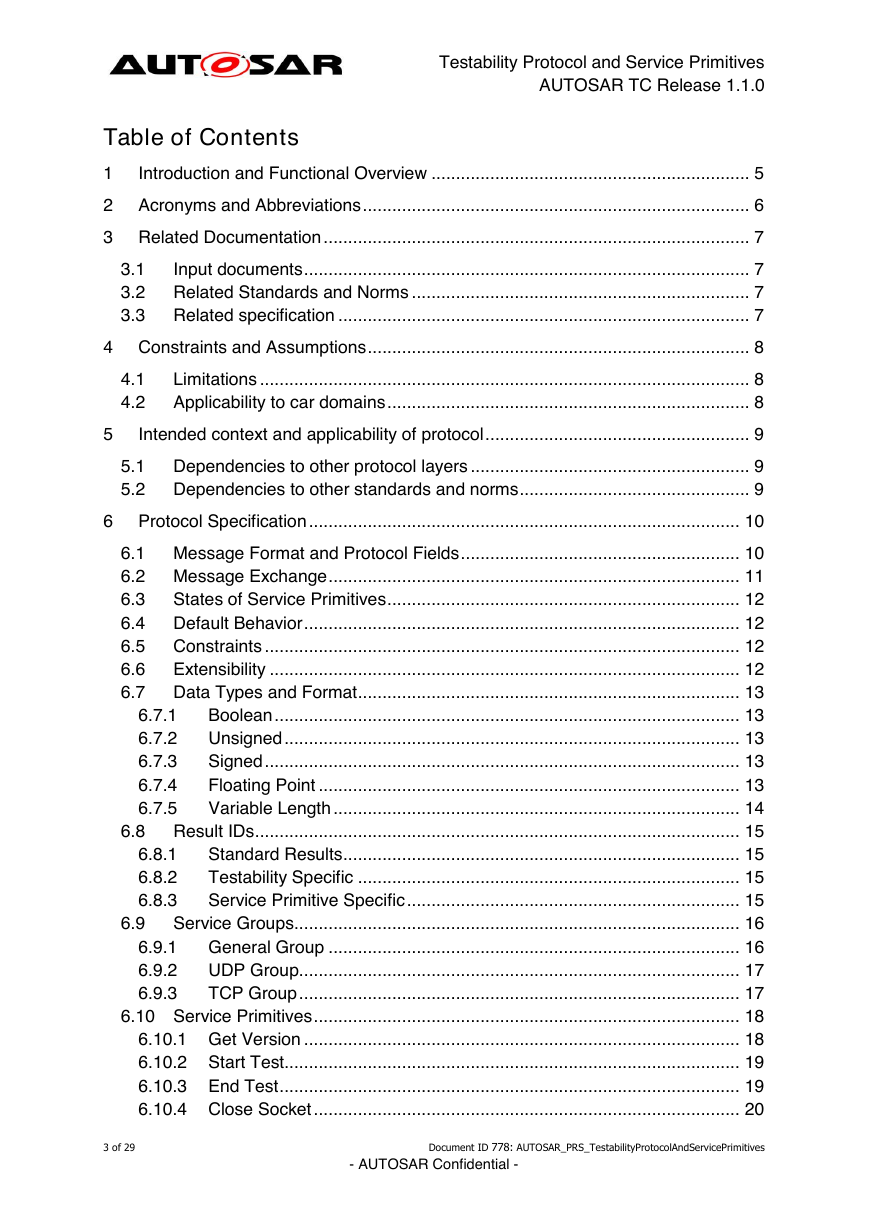
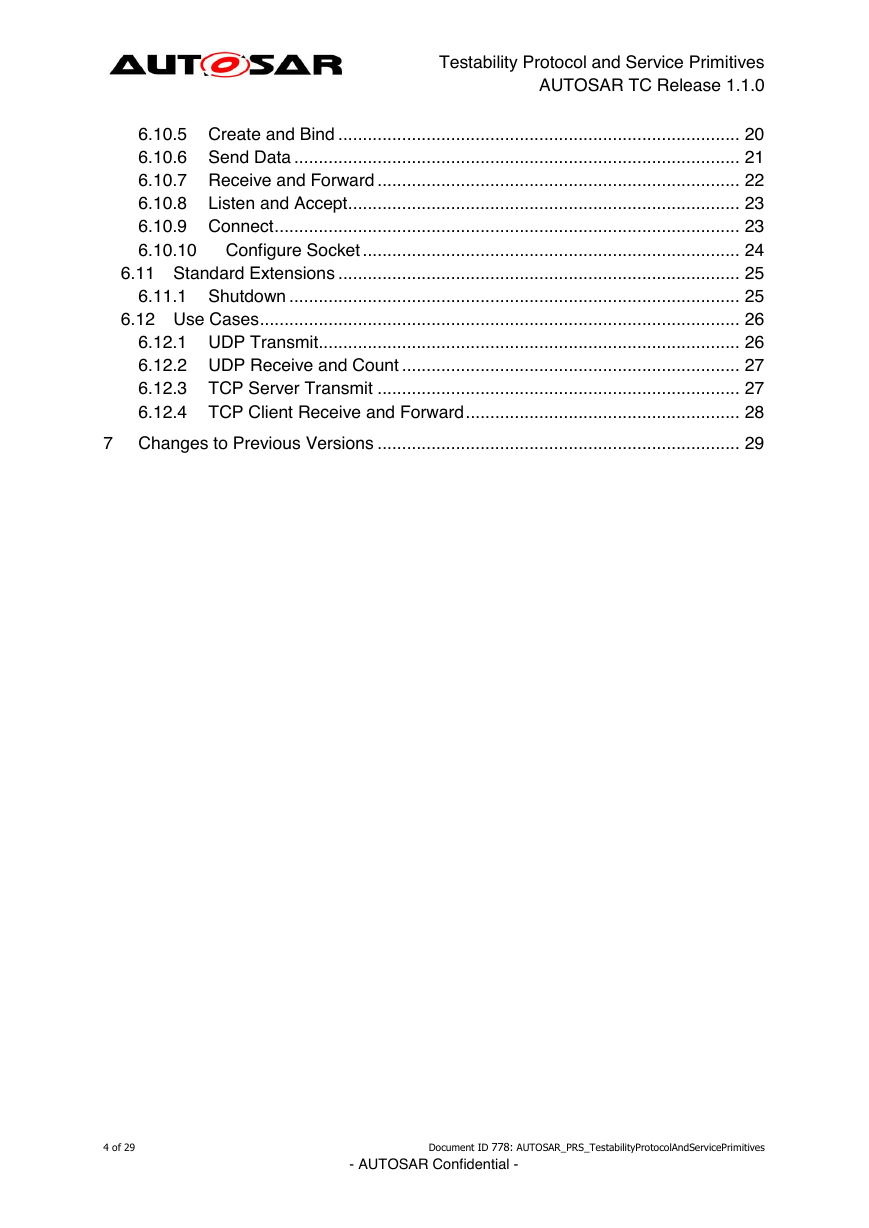
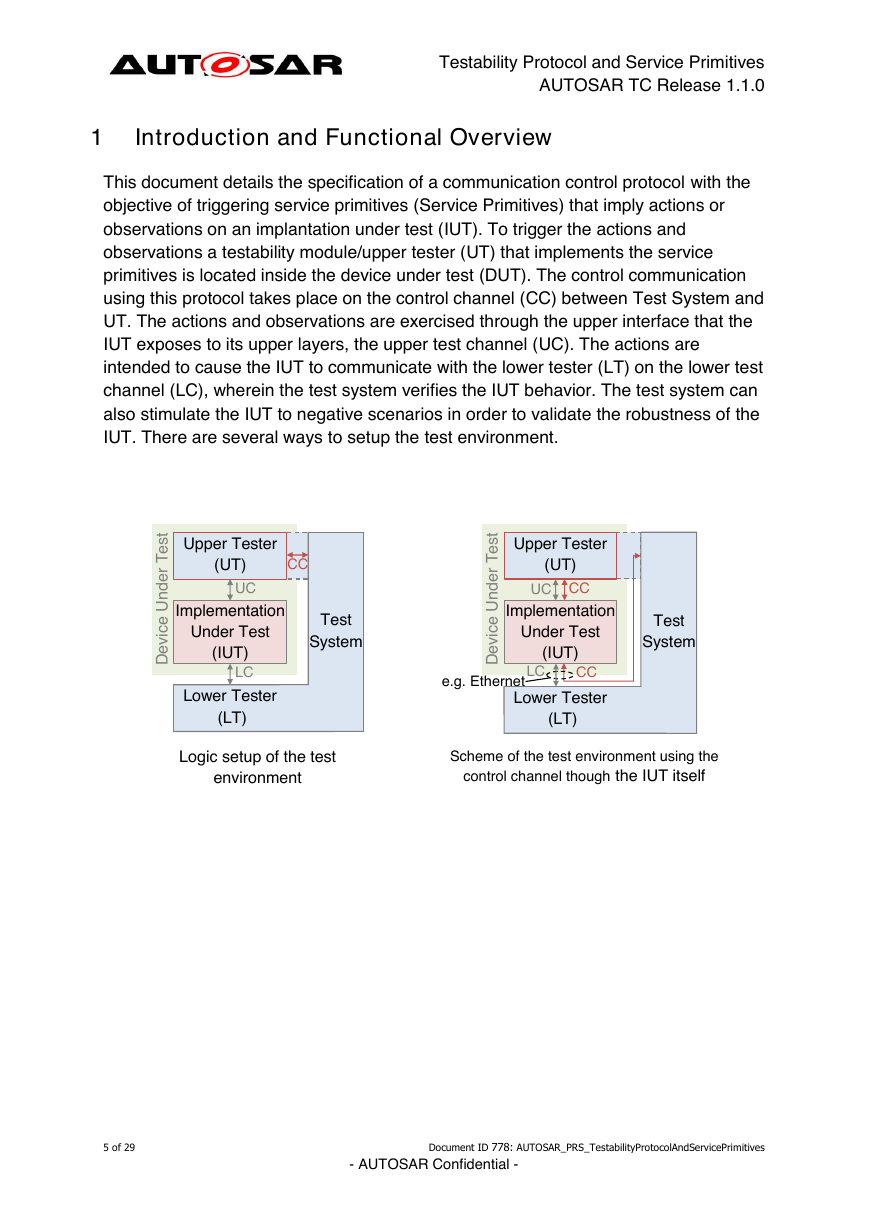
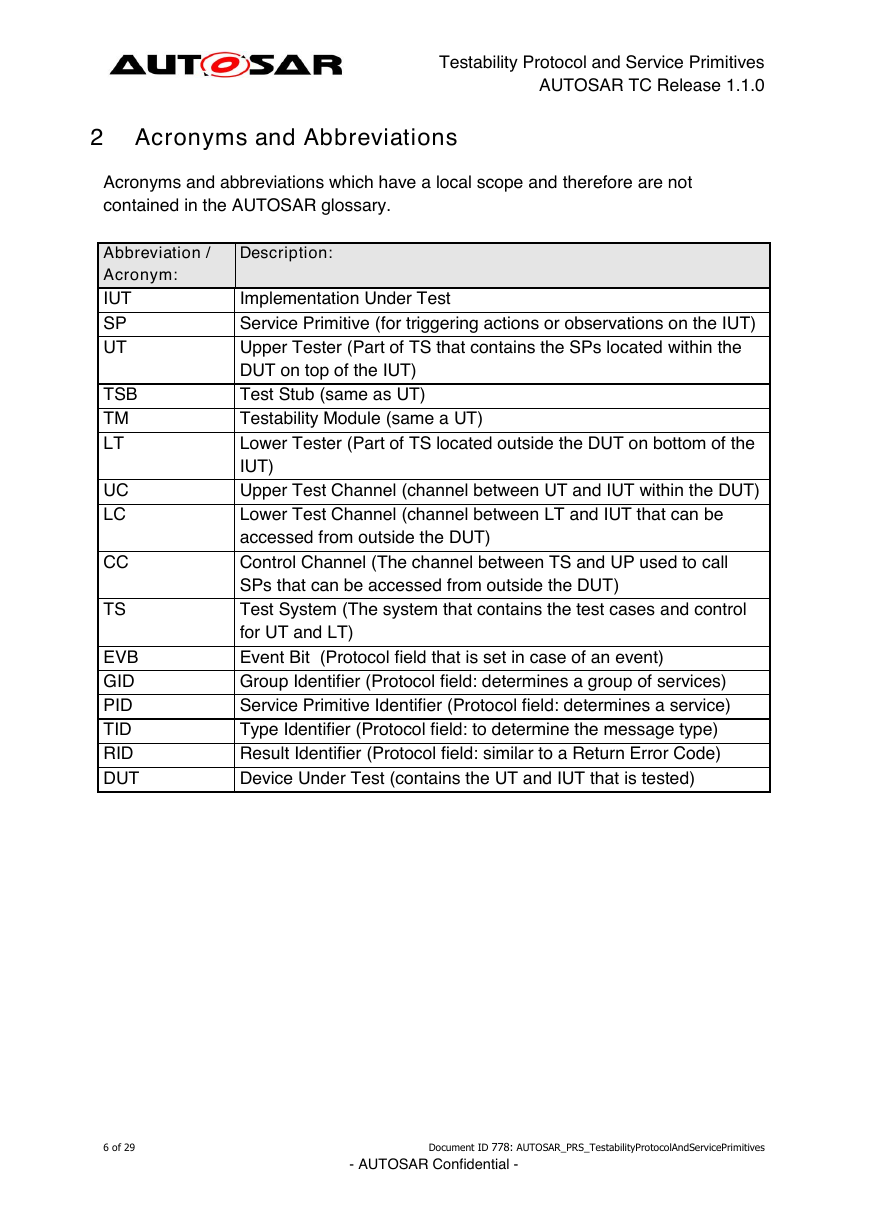










 2023年江西萍乡中考道德与法治真题及答案.doc
2023年江西萍乡中考道德与法治真题及答案.doc 2012年重庆南川中考生物真题及答案.doc
2012年重庆南川中考生物真题及答案.doc 2013年江西师范大学地理学综合及文艺理论基础考研真题.doc
2013年江西师范大学地理学综合及文艺理论基础考研真题.doc 2020年四川甘孜小升初语文真题及答案I卷.doc
2020年四川甘孜小升初语文真题及答案I卷.doc 2020年注册岩土工程师专业基础考试真题及答案.doc
2020年注册岩土工程师专业基础考试真题及答案.doc 2023-2024学年福建省厦门市九年级上学期数学月考试题及答案.doc
2023-2024学年福建省厦门市九年级上学期数学月考试题及答案.doc 2021-2022学年辽宁省沈阳市大东区九年级上学期语文期末试题及答案.doc
2021-2022学年辽宁省沈阳市大东区九年级上学期语文期末试题及答案.doc 2022-2023学年北京东城区初三第一学期物理期末试卷及答案.doc
2022-2023学年北京东城区初三第一学期物理期末试卷及答案.doc 2018上半年江西教师资格初中地理学科知识与教学能力真题及答案.doc
2018上半年江西教师资格初中地理学科知识与教学能力真题及答案.doc 2012年河北国家公务员申论考试真题及答案-省级.doc
2012年河北国家公务员申论考试真题及答案-省级.doc 2020-2021学年江苏省扬州市江都区邵樊片九年级上学期数学第一次质量检测试题及答案.doc
2020-2021学年江苏省扬州市江都区邵樊片九年级上学期数学第一次质量检测试题及答案.doc 2022下半年黑龙江教师资格证中学综合素质真题及答案.doc
2022下半年黑龙江教师资格证中学综合素质真题及答案.doc